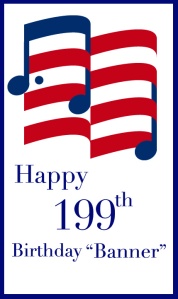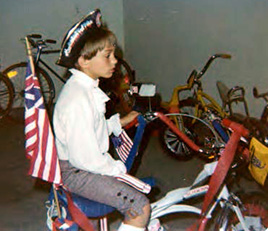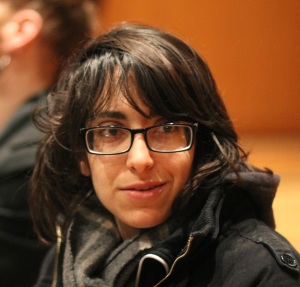 Kickstarter and Indiegogo have launched thousands of music, film, theatre and art projects. Indiegogo doesn’t make its stats readily available, but Kickstarter does. In music alone, the site has funded over 14,000 projects to the tune of over $84 million (that’s an average of about $6000 per project). The funding potential of the crowd is incredible and given the state of the arts economy, it’s likely that this source of venture capital will increasingly be tapped by individual artistic entrepreneurs as well as institutions. Donors like investing in the ideas and individuals behind crowd funding pitches (it’s fun); crowdfunding invites artists to develop ideas into a coherent pitch that underscores impact and value. Yet only about 55% of projects reach their goal. Having just completed a successful Indiegogo campaign for my own project—a set of recordings and a book of musical scores tracing the history of the U.S. national anthem—I wanted to share some observations and potentially advice that I learned from the journey.
Kickstarter and Indiegogo have launched thousands of music, film, theatre and art projects. Indiegogo doesn’t make its stats readily available, but Kickstarter does. In music alone, the site has funded over 14,000 projects to the tune of over $84 million (that’s an average of about $6000 per project). The funding potential of the crowd is incredible and given the state of the arts economy, it’s likely that this source of venture capital will increasingly be tapped by individual artistic entrepreneurs as well as institutions. Donors like investing in the ideas and individuals behind crowd funding pitches (it’s fun); crowdfunding invites artists to develop ideas into a coherent pitch that underscores impact and value. Yet only about 55% of projects reach their goal. Having just completed a successful Indiegogo campaign for my own project—a set of recordings and a book of musical scores tracing the history of the U.S. national anthem—I wanted to share some observations and potentially advice that I learned from the journey.
The Details
We raised $13,497 from 144 funders through a 33-day Indiegogo campaign with an initial goal of $11,700 (click here to see the campaign). We chose Indiegogo because it allowed us to raise funds as a 501(c)(3) non-profit foundation, so that contributions could be tax deductible. (Kickstarter is better known but does not facilitate non-profit tax deductions.) For us, the non-profit facilitation encouraged larger donations as well as board participation. That several of our non-profit directors took an active role in the fundraising campaign by sending personal emails and forwarding campaign communications likewise proved key to our success.
Back in 2010, I worked with four supporters to create the Star Spangled Music Foundation and we successfully applied for 501(c)(3) status. That we launched our first crowdfunding campaign with an established website, several successful grant proposals to our credit, and preliminary results from our recording project already on our Youtube channel, propelled our success. (For those who don’t want the expense or administrative work of creating their own non-profit, Fractured Atlas offers a collaborative option that may work for you.)n
All 0r Nothing vs. Flexible Funding
We used Indiegogo’s “flexible funding” option that allows any funds raised to be distributed to the campaign. This is opposed to the all-or-nothing option. The flexible option made the campaign less emotionally precipitous, but misses out on the inspiration that the possibility of failure presents. Donors may dig deeper if they know that falling short means nothing happens. The choice, however, really depends on your project. If you need a minimum amount of money to do the project at all, you need the protection that an all-or-nothing funding scheme offers since you can’t deliver on your perks if you don’t raise that minimum starting fund. If you fall short, no money is collected and promised donor perks are void. Since we were raising money to expand the presentation and distribution of a recording we had already made (using earlier grant monies that were already on hand), we knew we could deliver on our promises regardless of the outcome. Our board was willing to donate enough to keep our commitments even if the Indiegogo campaign fell short. If you can’t afford only partial success, don’t use flexible funding. Also, even with flexible funding, there is a need to meet your goal (and thus set reasonable goals) as we received a 3% service fee discount after reaching our goal. This reduced our fees to about 7% overall.
Communication
We used email and Facebook to spread the word. A free MailChimp account facilitated our email strategy. We had only about 435 contacts in our email list and if we did the campaign again, I’d certainly try to double that list. I’d recommend starting your email list at least two-weeks in advance of your campaign launch, and even earlier would be better. Aim for 1000 contacts. Organize your list into categories that will allow you to target different recipients: friends and colleagues, project collaborators, news outlets and blogs. As email recipients donated, I moved them into a donor category. As the communications matured, our pitch shifted from 1) hey, check out this great idea to 2) we’re gonna succeed with your help, to 3) don’t miss out, contribute now! After posting our campaign, we received a half dozen offers from support businesses to help with press releases or to increase our social media presence. We explored but chose to bypass these services.
The Video
I made two completely different versions of the video and was much more comfortable with the process the second time around. I learned to use a tight “close up” shot so that my face was clearly visible and my personality and emotion come through along with the pitch. I shared the video drafts with friends and potential supporters to get valuable feedback and to build commitment from my collaborators and potential donors. In the end, I think my video was too long, but I trusted that donors interested in K-12 education would give me 5 minutes of their time. Such a long video may have limited the potential of our project to go viral. All but a handful of donors came through people someone involved with the project knew personally. Here’s the video we used:
Donation Dynamics
My campaign followed what is apparently a typical pattern in which there is slow, but encouraging initial response from close friends and family and then a final burst of donations as time is expiring. In the 33 days of the campaign, daily donations ranged from $0 to $2000. Days with no gifts were depressing, while a great response put a jump in my step. The challenge is propelling your contacts to take action, and I found email much more effective than social media in this regard. We counteracted the mid-campaign doldrums with a 1:1 matching campaign. This led to the single best day of donations in the 33-day effort. When friends told me they planned to donate but hadn’t done so yet, I told asked them to add their promised contribution to a matching fund. It was also an advantage for us that we were an established non-profit with a business account such that we could accept checks in the name of the foundation as well. We received emails from some donors who were not comfortable giving online and they mailed in checks that added another $2000 to our fundraising total. In response, I added a “What Is Indiegogo?” section to my emails and if I were to do it over again, I’d probably add a mailing address for checks to the emails as well.
Social Media
Social media alone did not result in many contributions. It may be that since Facebook trains people to act only in ways that ask for limited effort — say the posting of pithy comments, a quick birthday wish, or simply by clicking “like,” that the more involved proposition of going to another website, watching a pitch video, selecting a donor perk, getting out your credit card and registering on the site was too much to ask. We are more accustomed to thoughtful engagement with email communication, however, so it may be that email is a more natural vehicle for calls to action, such as a fundraising pitch.
Email
We sent out about sixteen emails during the course of the campaign as well as five updates through the Indiegogo site. Emails were targeted to specific audiences: two went as press releases to news agencies (these produced no stories or coverage), eight went out to potential donors, two went to project collaborators and other institutional partners to encourage them to spread the news and help recruit donors, two went to previous donors to thank them and encourage them to spread the news, two others targeted new potential donors added to our email list mid-campaign. I also sent individual emails to some friends and institutional partners early in the campaign to help jumpstart activity. About 25% of our email list donated to the campaign. Some who I barely knew were extraordinarily generous; others who I knew well never responded. As far as I know, we received no boost from the Indiegogo site and were never featured in such as way as to inspire unexpected donations. This was disappointing. I was told by others who had done successful crowdfunding campaigns to send out emails every 2 or 3 days and that coming up with enough inspiring communication material was one reason to keep the campaign short. Since my list was made up primarily of friends, family, and professional contacts, I was reluctant to spam them too badly, so erred (especially mid-campaign) on the side of less communication. I found that emails during the week were more productive than those sent on the weekend. One sent on a Saturday evening produced only one donation that day and none on Sunday, but led to more activity on Monday morning.
The Emotional Roller Coaster
As the campaign matured and we got closer to success, I found myself more able to pull away from watching for contributions. Before then it was easy to become obsessive. I also came to appreciate that some of my contacts would never donate: maybe their spam filters captured my emails, maybe they didn’t like the idea or had other priorities, maybe they just weren’t in the habit of donating to things. I learned to not take it personally, but I sent thank you emails to those who did contribute. Ideally soon after their gift. The campaign overall was both time and mind-consuming. I got less done on the project itself during this period, as managing the campaign took much of my time and attention. Making the goal was fantastic, but also exhausting.
Benefits
Raising money to make your dream possible is certainly the most important benefit of crowdfunding, yet it’s not the only one. In addition to raising funds, your crowdfunding effort serves as a great marketing tool to get the word out about your project. Making your goal gives your effort a boost; it shows people care about what you do and gives you the sheen of success. We raised funds, but we also raised friends. Today’s mediascape is open but cacophonous and it’s difficult to be heard above the din. Our crowdfunding campaign cut through — at least among our own social circles. I also think that putting the campaign together helped our foundation to better articulate its goals and to develop a stronger project. We also worked hard to improve our website during the campaign and added content and playlists to our Youtube channel, which raised the quality of the whole effort. Our website traffic increased about 500% during the campaign and remains stronger even now after the campaign has finished. We’ve also built a database of 150 supporters who we will share news with in the future and who we hope will continue to be interested in and support our work.
Seek Advice and Take Your Time
I spoke with three creators of previously successful crowdfunding campaigns to get advice and insights into the process. (One of the best was a talk by U-M SMTD alumnus and Open Goldberg Project Co-Founder Robert Douglass who gave a talk for Arts Enterprise — click here.) I also read the many online guides and suggestions on the Kickstarter and Indiegogo sites. From each source I found things to imitate as well as suggestions that seemed less applicable to our specific situation. In the end, I think you can be both successful and true to your own ideas and ideals. I can also admit that I delayed the anticipated start of our campaign for a couple of weeks as it became clear that being successful was more than a great video and project description. You have to develop a strong communications plan and large list of email addresses. You need a plan for a matching fund and for future information updates that show that your project is progressing even as the campaign continues. It’ll never be perfect, but don’t rush into the campaign without preparing for your email communications.
Conclusions
Crowdfunding is a powerful tool and for our purposes the Indiegogo 501(c)(3) benefits were worth any sacrifice in name recognition. Having succeeded, I can enjoy the bonus emotional boost and the sheen of success that the crowdfunding campaing has given our organization. There is risk, however, as to fail might damage not just this one project, but the organization. Yet, I think the risk is worth it, especially if you make the commitment to giving your crowdfunding campaign your best effort.












